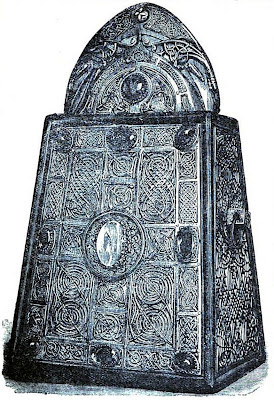The Irish for a bell is clog, akin to the English clock. St. Patrick and his disciples constantly used consecrated bells in their ministrations. How numerous they were in Patrick's time we may understand from the fact, that whenever he left one of his disciples in charge of a church, he gave him a bell: and it is recorded that on the churches of one province alone—Connaught—he bestowed fifty. To supply these he had in his household three smiths, whose chief occupation was to make bells. The most ancient Irish bells were quadrangular in shape, with rounded corners, and made of iron: facts which we know both from the ecclesiastical literature, and from the specimens that are still preserved.
The bell of St. Patrick, which is more than fourteen hundred years old, is now in the National Museum in Dublin, it is the oldest of all; and it may be taken as a type of the hammered-iron bells. Its height is (5 A inches: at the mouth the two dimensions are 4$ by 8| inches. It is made of two iron plates, bent into shape by hammering, and slightly overlapped at the edges for riveting. After the joints had been riveted, the bell was consolidated by the fusion of bronze into the joints and over the surface—probably by dipping into melted bronze— which also increased its resonance. This is the bell known as the "Bell of the Will"; and it is much celebrated in the Lives of St. Patrick. A beautiful and costly shrine was made to cover and protect this venerable relic, by order of Donall O'Logl1lin, king of Ireland (died 1121): and tlns gorgeous piece of ancient Irish art, with O'Loghlin's name and three others inscribed on it, is also preserved in the National Museum.
Many others of these venerable iron bronzed bells, belonging to the primitive Irish saints, are preserved in the National and other Museums, several covered with ornamental shrines.
This Image (or other media file) is in the public domain because its copyright has expired. This applies to the United States, where Works published prior to 1978 were copyright protected for a maximum of 75 years. See Circular 1 "COPYRIGHT BASICS" PDF from the U.S. Copyright Office. Works published before 1923 in this case 1908, are now in the public domain.
TEXT and IMAGE CREDIT: A smaller social history of ancient Ireland: treating the government, military system and law, religion, learning and art, trades, industries and commerce, manners, customs and domestic life of the ancient Irish people.
Author: Patrick Weston Joyce. Edition: 2. Publisher: Longmans, Green and Co., 1908. Original from: Princeton University. Digitized: Apr 2, 2009. Length: 574 pages. Subjects: Ireland.


No comments:
Post a Comment